Chapter 6 - Photosynthesis Exercise 74
Question 1
Answer the following:
(i) Give the overall chemical equation of photosynthesis in green plants.
(ii) Mention two significant advantages of photosynthesis to the living world as a whole.
(i) Give the overall chemical equation of photosynthesis in green plants.
(ii) Mention two significant advantages of photosynthesis to the living world as a whole.
Solution 1
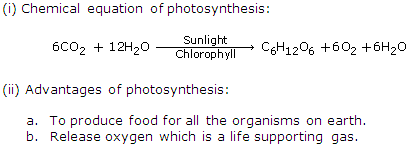
Question 2
Define the following:
(i) Plant pigments
(ii) Quantum
(iii) Organic food
(iv) Light reaction
(v) Photolysis in photosynthesis
(i) Plant pigments
(ii) Quantum
(iii) Organic food
(iv) Light reaction
(v) Photolysis in photosynthesis
Solution 2
(i) Plant pigments - Plant pigments are a variety of different kinds of molecules present in plants that absorb certain wavelengths of light while reflecting others.
(ii) Quantum - Quantum are the discrete packets which stores energy and these particles can be changed from one form to another.
(iii) Organic food - The food that is produced by using methods that do not involve synthetic inputs such as synthetic pesticides and chemical fertilizers is called organic food.
(iv) Light reaction - The reaction of photosynthesis which takes place in the presence of light is called light reaction.
(v) Photolysis in photosynthesis - The process of splitting of water by sunlight during light reaction of photosynthesis is called photolysis in photosynthesis.
(ii) Quantum - Quantum are the discrete packets which stores energy and these particles can be changed from one form to another.
(iii) Organic food - The food that is produced by using methods that do not involve synthetic inputs such as synthetic pesticides and chemical fertilizers is called organic food.
(iv) Light reaction - The reaction of photosynthesis which takes place in the presence of light is called light reaction.
(v) Photolysis in photosynthesis - The process of splitting of water by sunlight during light reaction of photosynthesis is called photolysis in photosynthesis.
Question 3

Solution 3
Question 4
Distinguish between the following:
(i) Hill reaction and NADP reduction in chloroplast.
(ii) Photosynthesis and photophosphorylation.
(i) Hill reaction and NADP reduction in chloroplast.
(ii) Photosynthesis and photophosphorylation.
Solution 4
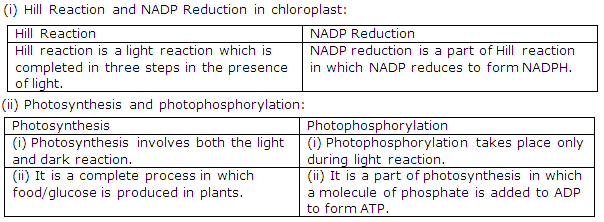
Question 5
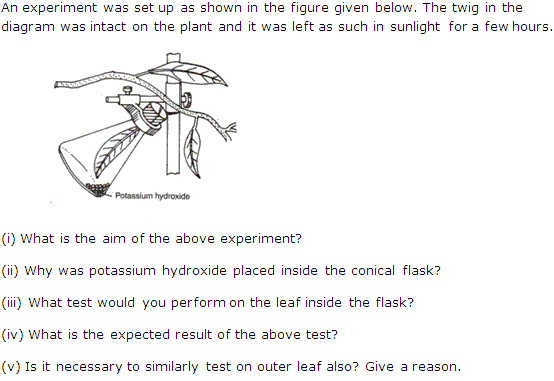
Solution 5
(i) The aim of the experiment is to prove that CO2 is necessary for photosynthesis.
(ii) Potassium hydroxide absorbs CO2 from the surrounding. It is placed to remove CO2 within the conical flask.
(iii) The leaf inside the conical flask would be tested for the presence of starch by the application of iodine.
(iv) The expected result of the above test is - No change in the colour will be observed.
(v) Yes, it is necessary to similarly test on the outer leaf also to show that leaves present in CO2 show photosynthesis.
(ii) Potassium hydroxide absorbs CO2 from the surrounding. It is placed to remove CO2 within the conical flask.
(iii) The leaf inside the conical flask would be tested for the presence of starch by the application of iodine.
(iv) The expected result of the above test is - No change in the colour will be observed.
(v) Yes, it is necessary to similarly test on the outer leaf also to show that leaves present in CO2 show photosynthesis.
Question 6
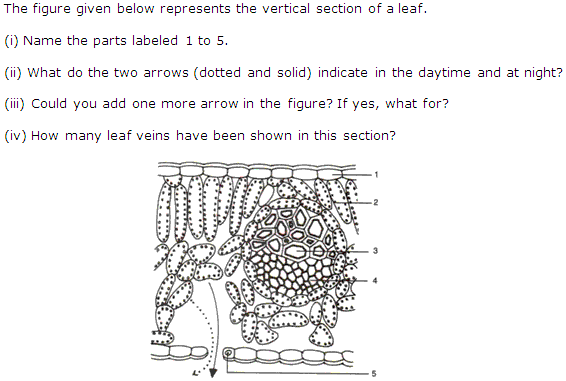
Solution 6
(i) 1 - Upper Epidermis; 2 - Palisade layer / chloroplast; 3 - Xylem; 4 - Phloem; 5 - Guard cell
(ii) The two arrows show the release of oxygen and water vapours during the daytime and carbon dioxide and very less amount of oxygen is released during the night.
(iii) Yes, one more arrow can be added to show the absorption of carbon dioxide by the leaf.
(iv) One vein has been shown in this section.
(ii) The two arrows show the release of oxygen and water vapours during the daytime and carbon dioxide and very less amount of oxygen is released during the night.
(iii) Yes, one more arrow can be added to show the absorption of carbon dioxide by the leaf.
(iv) One vein has been shown in this section.
Question 7
Give any four differences between photosynthesis and respiration.
Solution 7
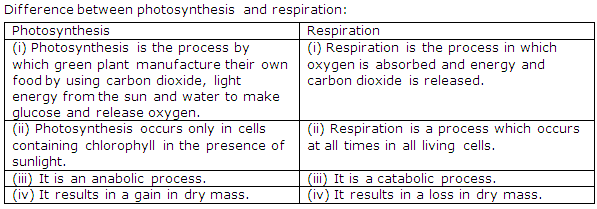
Question 8
(i) Define dark reaction.
(ii) Give an overall balanced equation of this process.
(iii) Describe an experiment to prove that sunlight is necessary for photosynthesis.
(iv) Mention any two points in which photosynthesis and respiration in plants are opposite to each other.
(ii) Give an overall balanced equation of this process.
(iii) Describe an experiment to prove that sunlight is necessary for photosynthesis.
(iv) Mention any two points in which photosynthesis and respiration in plants are opposite to each other.
Solution 8
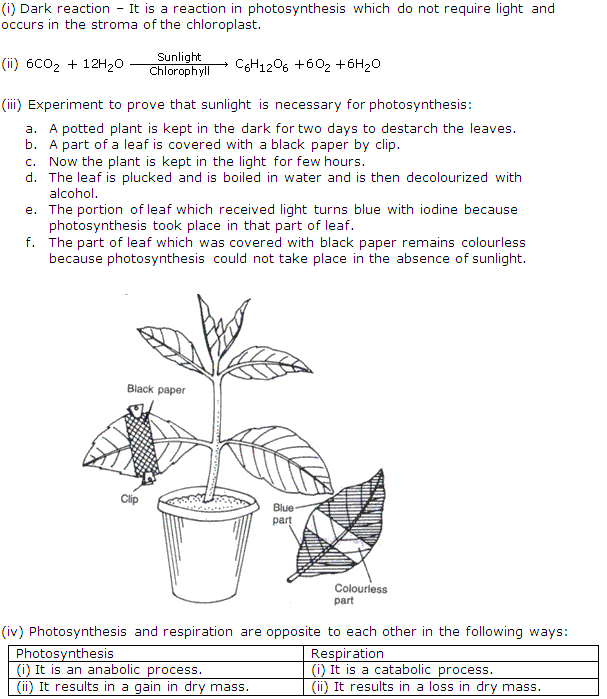
Question 9
(i) What is meant by photosynthesis? Why is it so important in nature?
(ii) Describe fully one experiment with potted green plant to show that starch is not produced in the leaves when carbon dioxide is not available (diagrams essential)
(iii) A healthy oat seeding in a pot is transferred from light to any airy but completely dark room. How would it differ from its original condition in appearance after about a week? Explain the difference.
(ii) Describe fully one experiment with potted green plant to show that starch is not produced in the leaves when carbon dioxide is not available (diagrams essential)
(iii) A healthy oat seeding in a pot is transferred from light to any airy but completely dark room. How would it differ from its original condition in appearance after about a week? Explain the difference.
Solution 9
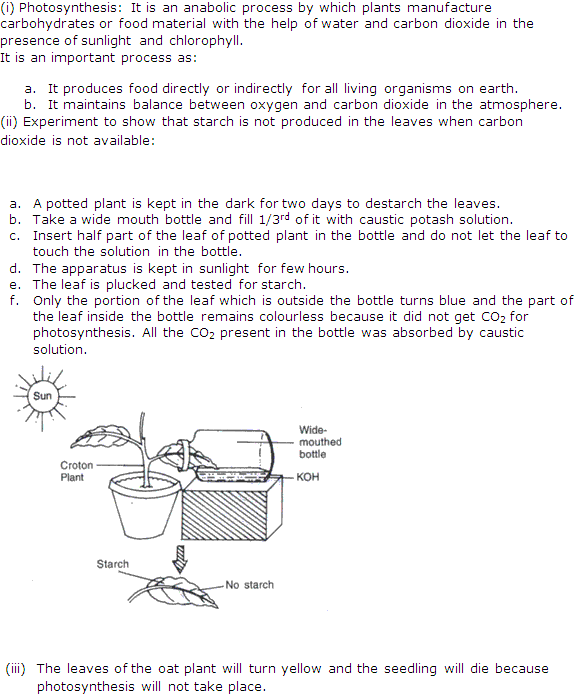
Chapter 6 - Photosynthesis Exercise 75
Question 1
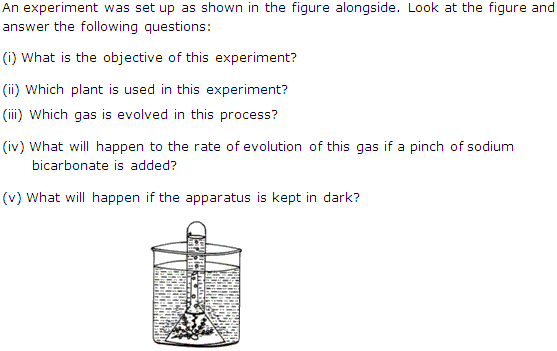
Solution 1
(i) The objective of this experiment is to prove that oxygen is released during photosynthesis.
(ii) Hydrilla
(iii) Oxygen
(iv) The rate of photosynthesis will increase and the rate of bubbling also increases when sodium bicarbonate is added.
(v) Photosynthesis will not take place.
(ii) Hydrilla
(iii) Oxygen
(iv) The rate of photosynthesis will increase and the rate of bubbling also increases when sodium bicarbonate is added.
(v) Photosynthesis will not take place.
Question 2
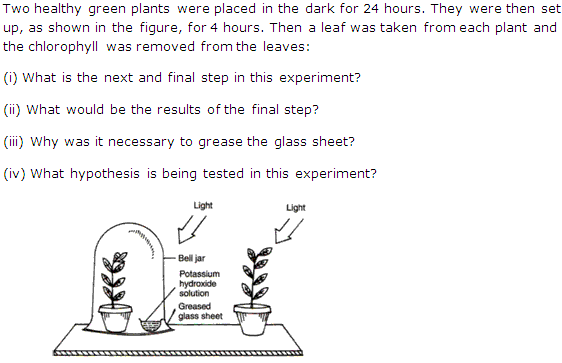
Solution 2
(i) The leaf is then treated with iodine solution.
(ii) The leaf from first plant will not show starch test while the leaf from second plant will become blue-black showing the presence of starch.
(iii) It is necessary to grease the glass sheet to prevent the entry of air containing CO2.
(iv) The hypothesis that CO2 is necessary for photosynthesis is being tested in this experiment.
(ii) The leaf from first plant will not show starch test while the leaf from second plant will become blue-black showing the presence of starch.
(iii) It is necessary to grease the glass sheet to prevent the entry of air containing CO2.
(iv) The hypothesis that CO2 is necessary for photosynthesis is being tested in this experiment.
Question 3
What is the effect of light intensity on the rate of photosynthesis in leaves?
Solution 3
Light intensity is directly proportional to sunlight. Increase in intensity of light increases the rate of photosynthesis. Photosynthesis is maximum in red light followed by blue light and is least in green light.
Question 4
(i) Mention two ways in which photosynthesis is useful to life.
(ii) Explain why respiration is said to be a reversal of photosynthesis?
(iii) What is the role of chlorophyll in green plant?
(ii) Explain why respiration is said to be a reversal of photosynthesis?
(iii) What is the role of chlorophyll in green plant?
Solution 4
(i) Advantages of photosynthesis:
(a) To produce food for all the organisms on earth.
(b) Release oxygen which is a life supporting gas.
(ii) Respiration is a catabolic process while photosynthesis is an anabolic process. During respiration oxygen is taken and carbon dioxide is given out while during photosynthesis carbon dioxide is taken and oxygen is given out.
(iii) Chlorophyll is a green coloured pigment found in green plants. it absorbs light energy which is utilized for the formation of ATP and reduction of NADP during photosynthesis.
(a) To produce food for all the organisms on earth.
(b) Release oxygen which is a life supporting gas.
(ii) Respiration is a catabolic process while photosynthesis is an anabolic process. During respiration oxygen is taken and carbon dioxide is given out while during photosynthesis carbon dioxide is taken and oxygen is given out.
(iii) Chlorophyll is a green coloured pigment found in green plants. it absorbs light energy which is utilized for the formation of ATP and reduction of NADP during photosynthesis.
Question 5
Difference between an autotroph and a heterptroph. Give one example of each organism.
Solution 5

Question 6
What is the difference between chloroplast and the chlorophyll?
Solution 6

Question 7
Name only two plants you are familiar with, which have no chlorophyll.
Solution 7
Coelus and mushroom.
Question 8
Why is the upper surface of broad leaves greener than their lower surface?
Solution 8
It is because the upper surfaces of broad leaves are directly exposed to sunlight which leads to maximize the rate of photosynthesis.
Question 9

Solution 9
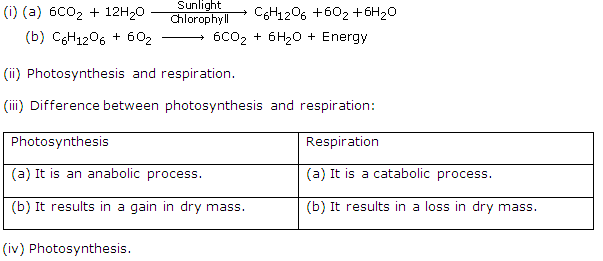
Question 10
Complete the following statement by choosing the correct alternative from the ones given within the brackets:
All animals would die on the earth if there was no ______.
(chlorophyll, haemoglobin, penicillin)
All animals would die on the earth if there was no ______.
(chlorophyll, haemoglobin, penicillin)
Solution 10
Chlorophyll.
Question 11
Photosynthesis stops to occurs at a temperature above 35oC. (True/False)
Solution 11
True
Question 12
Photosynthesis occurs in all the cells of the plant. (True/False)
Solution 12
False
Question 13
Explain briefly how during the day transpiration and photosynthesis are interlinked.
Solution 13
During the day transpiration and photosynthesis are interlinked as the stomata opens to facilitate the inward diffusion of carbon dioxide for photosynthesis which also leads to loss of water vapours to the outside during transpiration.
Chapter 6 - Photosynthesis Exercise 76
Question 1
A potted destarched plant was taken in order to prove that light is necessary for photosynthesis.
(i) What is meant by 'destarched plant'? How can it be destarched?
(ii) Using the destarched plant describe step by step how you would proceed to prove that in the absence of light the leaf cannot manufacture starch.
(i) What is meant by 'destarched plant'? How can it be destarched?
(ii) Using the destarched plant describe step by step how you would proceed to prove that in the absence of light the leaf cannot manufacture starch.
Solution 1
(i) Destarched plant is the plant which lacks starch. Destarching is done by keeping the plant in dark for 2-3 days or covering a part of a leaf with a black paper by clip.
(ii) (a) The leaf is plucked and is boiled in water and decolourized with alcohol.
(b) The portion of leaf which received light turns blue with iodine because photosynthesis took place in that part of leaf.
(c) The part of leaf which was covered with black paper remains colourless because photosynthesis could not take place in the absence of sunlight.
This shows that starch is not manufactured in the absence of light.
(ii) (a) The leaf is plucked and is boiled in water and decolourized with alcohol.
(b) The portion of leaf which received light turns blue with iodine because photosynthesis took place in that part of leaf.
(c) The part of leaf which was covered with black paper remains colourless because photosynthesis could not take place in the absence of sunlight.
This shows that starch is not manufactured in the absence of light.
Question 2
Name the following:
(i) The principle site in a green leaf for photosynthesis.
(ii) The products that are formed as a result of photosynthesis.
(iii) Three organisms that cannot prepare their own food by photosynthesis.
(iv) The main reaction by which the molecule of water is broken down by means of light.
(v) The main mineral constituent of chlorophyll.
(vi) The cell organelle responsible for photosynthesis.
(i) The principle site in a green leaf for photosynthesis.
(ii) The products that are formed as a result of photosynthesis.
(iii) Three organisms that cannot prepare their own food by photosynthesis.
(iv) The main reaction by which the molecule of water is broken down by means of light.
(v) The main mineral constituent of chlorophyll.
(vi) The cell organelle responsible for photosynthesis.
Solution 2
(i) Chloroplast.
(ii) Glucose and oxygen.
(iii) Fungi, insects and animals.
(iv) Photolysis.
(v) Magnesium.
(vi) Chloroplast.
(ii) Glucose and oxygen.
(iii) Fungi, insects and animals.
(iv) Photolysis.
(v) Magnesium.
(vi) Chloroplast.
Question 3
The following statements are about photosynthesis in a green plant. Write whether each is True or False.
(i) The raw materials for photosynthesis include water and carbon dioxide.
(ii) Land plants obtain their carbon dioxide from the atmosphere.
(iii) Photosynthesis occurs in underground organs as well as in aerial ones.
(iv) Photosynthesis results in a gain in dry weight.
(v) A variegated leaf (one that has white as well as green patches) will only photosynthesize in the green areas.
(vi) The source of energy is light.
(vii) Green light is more effective than any other colour.
(viii) The growing tips of stems and roots will be photosynthesizing actively compared with the rest of the plant.
(ix) Photosynthesis produces oxygen.
(i) The raw materials for photosynthesis include water and carbon dioxide.
(ii) Land plants obtain their carbon dioxide from the atmosphere.
(iii) Photosynthesis occurs in underground organs as well as in aerial ones.
(iv) Photosynthesis results in a gain in dry weight.
(v) A variegated leaf (one that has white as well as green patches) will only photosynthesize in the green areas.
(vi) The source of energy is light.
(vii) Green light is more effective than any other colour.
(viii) The growing tips of stems and roots will be photosynthesizing actively compared with the rest of the plant.
(ix) Photosynthesis produces oxygen.
Solution 3
(i) True
(ii) True
(iii) False
(iv) True
(v) True
(vi) True
(vii) False
(viii) False
(ix) True
(ii) True
(iii) False
(iv) True
(v) True
(vi) True
(vii) False
(viii) False
(ix) True
Question 4
Fill in the blanks:
(i) ______ is the process which replenishes the atmospheric oxygen which the animal life consumes in respiration.
(ii) Land plants obtain their carbon dioxide from the ______.
(iii) Photosynthesis produces oxygen and ______.
(iv) Xanthophyll is ______ coloured pigment.
(v) Quantasome is the basic unit of ______.
(vi) The end products of photosynthesis are ______ and ______.
(vii) CO2 enters the leaf through ______.
(i) ______ is the process which replenishes the atmospheric oxygen which the animal life consumes in respiration.
(ii) Land plants obtain their carbon dioxide from the ______.
(iii) Photosynthesis produces oxygen and ______.
(iv) Xanthophyll is ______ coloured pigment.
(v) Quantasome is the basic unit of ______.
(vi) The end products of photosynthesis are ______ and ______.
(vii) CO2 enters the leaf through ______.
Solution 4
(i) Photosynthesis
(ii) Atmosphere
(iii) Glucose
(iv) Yellow
(v) Chloroplast
(vi) Glucose and oxygen
(vii) Stomata
(ii) Atmosphere
(iii) Glucose
(iv) Yellow
(v) Chloroplast
(vi) Glucose and oxygen
(vii) Stomata
Question 5
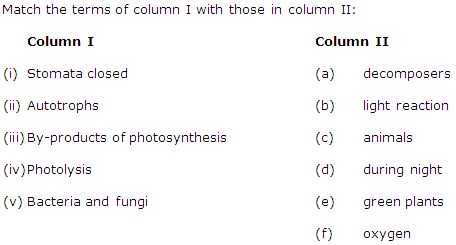
Solution 5
(i) (d) During night
(ii) (e) Green plants
(iii) (f) Oxygen
(iv) (b) Light reaction
(v) (a) Decomposers
(ii) (e) Green plants
(iii) (f) Oxygen
(iv) (b) Light reaction
(v) (a) Decomposers
Question 6
Fill in the blank with the function: Chloroplasts ______.
Solution 6
Chloroplasts are the cell organelles in green plants which have chlorophyll and thus serve as the main site of photosynthesis.
Question 7
Mention any three adaptations found in plants to favour the process of photosynthesis.
Solution 7
(i) Large surface area of leaves.
(ii) Presence of more stomata.
(iii) The thinness of leaves.
(ii) Presence of more stomata.
(iii) The thinness of leaves.
Question 8
Write a short note on carbon cycle.
Solution 8
Carbon cycle is a series of chemical reactions in which atmospheric carbon dioxide is used by the organisms and returned to the atmosphere. Photosynthetic plants use carbon as carbon dioxide from the air synthesizing organic compounds. By respiration, burning, decay, etc. the carbon is returned to the atmosphere.
Question 9
How does the carbon cycle maintain the balance of nature?
Solution 9
Carbon in the form of carbon dioxide enters living organisms and then goes back to the atmosphere through several pathways forming the true carbon cycle. Thus, it helps in maintaining the balance of nature.
Question 10
"Human activities are harmful to the balance of nature." Comment.
Solution 10
The amount of carbon dioxide in the atmosphere is increasing due to increased human activities like burning of fossil fuels, deforestation, etc. which cause the rise in global temperatures. This global warming result in melting of polar ice caps, floods in coastal areas, disturbance in hydrogenic cycle etc. Thus "Human activities are harmful to the balance of nature".
Question 11
How is carbon dioxide removed from the atmosphere? Explain.
Solution 11
Carbon dioxide is removed from the atmosphere by:
(i) Producers - Producers or green plants use carbon dioxide through photosynthesis. A small amount of carbon dioxide is used by chemosynthetic bacteria also.
(ii) Marine Organisms - Some amount of carbon dioxide is directly fixed by a few marine organisms and sea water absorbs carbon dioxide in the form of dissolved carbon dioxide, carbonic acid, carbonate and bicarbonates.
(i) Producers - Producers or green plants use carbon dioxide through photosynthesis. A small amount of carbon dioxide is used by chemosynthetic bacteria also.
(ii) Marine Organisms - Some amount of carbon dioxide is directly fixed by a few marine organisms and sea water absorbs carbon dioxide in the form of dissolved carbon dioxide, carbonic acid, carbonate and bicarbonates.
Chapter 6 - Photosynthesis Exercise 77
Question 1
How does carbon dioxide return to the atmosphere? Explain.
A student in order to study the importance of certain factors of photosynthesis took a potted plant and kept it in the dark for over 24 hours. Then in the early hours of the morning the student covered one of the leaves with black paper in the centre only. Student placed the potted plant in the sunlight for a few hours, and then tested the leaf which was covered with black paper for starch.
(i) What aspect of photosynthesis was being investigated?
(ii) Is there any control in this experiment? If so, state the name.
(iii) Why was the plant kept in the dark before the experiment?
(iv) Describe step by step how the candidate proceeded to test the leaf for the presence of starch.
A student in order to study the importance of certain factors of photosynthesis took a potted plant and kept it in the dark for over 24 hours. Then in the early hours of the morning the student covered one of the leaves with black paper in the centre only. Student placed the potted plant in the sunlight for a few hours, and then tested the leaf which was covered with black paper for starch.
(i) What aspect of photosynthesis was being investigated?
(ii) Is there any control in this experiment? If so, state the name.
(iii) Why was the plant kept in the dark before the experiment?
(iv) Describe step by step how the candidate proceeded to test the leaf for the presence of starch.
Solution 1
(a) Carbon dioxide is returned back to the atmosphere mainly through the following ways:
(i) Respiration - Animals and plants respire and release carbon dioxide in the atmosphere.
(ii) Decay - Plants and animals decay organic matter with the help of bacteria and fungi and release carbon dioxide.
(iii) Combustion - Plants and animals which got buried under the soil changed into coal and oil and releases carbon dioxide when these are burnt.
(iv) Ocean water - Carbon dioxide occurs in the form of lime stone in molluscan shells and as by product of photosynthesis in marine water.
(b) (i) To show that sunlight is needed for photosynthesis.
(ii) Yes, the uncovered portion of the experimental leaf is the control.
(iii) To destarch the leaf.
(iv) 1. Boil the leaf in alcohol.
2. Wash the leaf in water to make it soft.
3. Add iodine solution on the leaf. The portion uncovered shows blue-black colour and the portion covered shows brown colour. This indicates that sunlight is needed for photosynthesis.
(i) Respiration - Animals and plants respire and release carbon dioxide in the atmosphere.
(ii) Decay - Plants and animals decay organic matter with the help of bacteria and fungi and release carbon dioxide.
(iii) Combustion - Plants and animals which got buried under the soil changed into coal and oil and releases carbon dioxide when these are burnt.
(iv) Ocean water - Carbon dioxide occurs in the form of lime stone in molluscan shells and as by product of photosynthesis in marine water.
(b) (i) To show that sunlight is needed for photosynthesis.
(ii) Yes, the uncovered portion of the experimental leaf is the control.
(iii) To destarch the leaf.
(iv) 1. Boil the leaf in alcohol.
2. Wash the leaf in water to make it soft.
3. Add iodine solution on the leaf. The portion uncovered shows blue-black colour and the portion covered shows brown colour. This indicates that sunlight is needed for photosynthesis.
Question 2
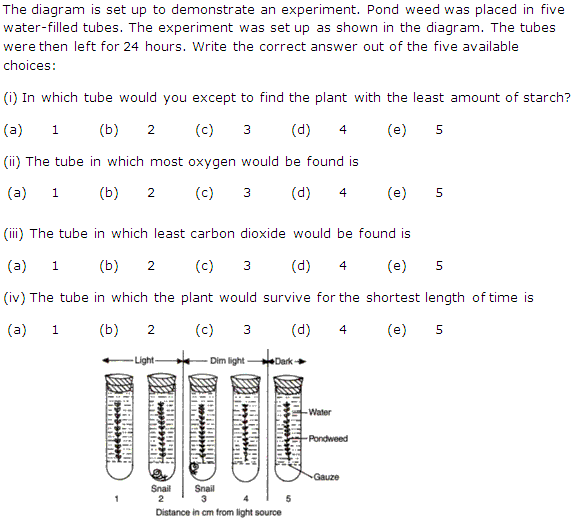
Solution 2
(i) (e) 5
(ii) (a) 1
(iii) (b) 2
(iv) (e) 5
(ii) (a) 1
(iii) (b) 2
(iv) (e) 5
Question 3
Complete the following by filling in the blanks numbered 1 to 10 with the appropriate word/term:
Photosynthesis involves light reaction and dark reaction. During light reaction, the chlorophyll present in the (1) ______ gets activated by absorbing light energy. This energy splits (2) ______ molecules to (3) ______ and oxygen and releases two electrons. This process is called (4) ______. The (5) ______ ions are picked up by NADP to form (6) ______. The ADP is converted to (7) ______. This process is called (8) ______. During the dark phase, the compound produced at the end of the light reaction reacts with carbon dioxide to form (9) ______. This product is converted to starch. The process is called (10) ______.
Photosynthesis involves light reaction and dark reaction. During light reaction, the chlorophyll present in the (1) ______ gets activated by absorbing light energy. This energy splits (2) ______ molecules to (3) ______ and oxygen and releases two electrons. This process is called (4) ______. The (5) ______ ions are picked up by NADP to form (6) ______. The ADP is converted to (7) ______. This process is called (8) ______. During the dark phase, the compound produced at the end of the light reaction reacts with carbon dioxide to form (9) ______. This product is converted to starch. The process is called (10) ______.
Solution 3
(1) leaves
(2) water
(3) hydrogen ion
(4) photolysis
(5) hydrogen
(6) NADPH2
(7) ATP
(8) photophosphorylation
(9) glucose
(10) polymerization
(2) water
(3) hydrogen ion
(4) photolysis
(5) hydrogen
(6) NADPH2
(7) ATP
(8) photophosphorylation
(9) glucose
(10) polymerization
Question 4
The diagram alongside refers to an experiment in which the apparatus was set up with the light source 10 cm away from the plant. After 15 minutes the number of bubbles evolved per minute from the cut stem was recorded. The light source was moved to 20 cm away from the plant, left for 15 minutes and the number of bubbles evolved per minute was again recorded. The experiment was repeated with the light source at distances of 40, 60, 80 and 100 cm away from the plant. Plot a graph for the results obtained and answer the following questions.
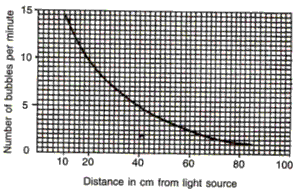
(i) From the graph it seems likely that the rate of bubbling per minute at 50 cm would have been
(a) 2.0 (b) 2.5 (c) 3.0 (d) 3.5
(ii) The gas produced by the plant during the experiment was
(a) air (b) oxygen (c) carbon dioxide (d) nitrogen (e) hydrogen
(iii) The gas collected comes due to the breakdown of
(a) glucose (b) starch (c) water (d) air (e) ATP
(iv) If ice cubes were added to the water, the rate of bubble formation would
(a) Stay the same.
(b) Increase because more water is added.
(c) Decrease because the temperature drops.
(d) Decrease because water freezes.
(e) Cannot tell from the information given.
(v) If some sodium bicarbonate is added to the water the rate of bubble formation
(a) Increases because more respiration occurs.
(b) Increases because more photosynthesis occurs.
(c) Increases because the gas becomes less soluble.
(d) Decreases because carbon dioxide acts as a limiting factor.
(e) Decreases because respiration decreases.

(i) From the graph it seems likely that the rate of bubbling per minute at 50 cm would have been
(a) 2.0 (b) 2.5 (c) 3.0 (d) 3.5
(ii) The gas produced by the plant during the experiment was
(a) air (b) oxygen (c) carbon dioxide (d) nitrogen (e) hydrogen
(iii) The gas collected comes due to the breakdown of
(a) glucose (b) starch (c) water (d) air (e) ATP
(iv) If ice cubes were added to the water, the rate of bubble formation would
(a) Stay the same.
(b) Increase because more water is added.
(c) Decrease because the temperature drops.
(d) Decrease because water freezes.
(e) Cannot tell from the information given.
(v) If some sodium bicarbonate is added to the water the rate of bubble formation
(a) Increases because more respiration occurs.
(b) Increases because more photosynthesis occurs.
(c) Increases because the gas becomes less soluble.
(d) Decreases because carbon dioxide acts as a limiting factor.
(e) Decreases because respiration decreases.
Solution 4
(i) (d) 3.5
(ii) (b) Oxygen
(iii) (c) Water
(iv) (c) Decrease because the temperature drops.
(v) (b) Increases because more photosynthesis occurs.
(ii) (b) Oxygen
(iii) (c) Water
(iv) (c) Decrease because the temperature drops.
(v) (b) Increases because more photosynthesis occurs.
Chapter 6 - Photosynthesis Exercise 78
Question 1
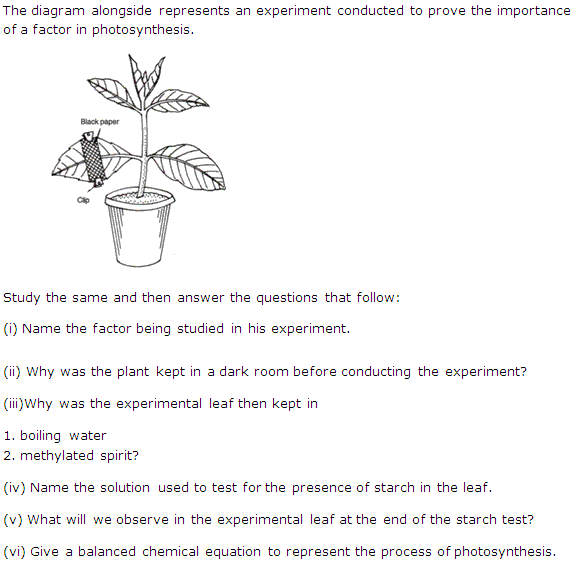
Solution 1
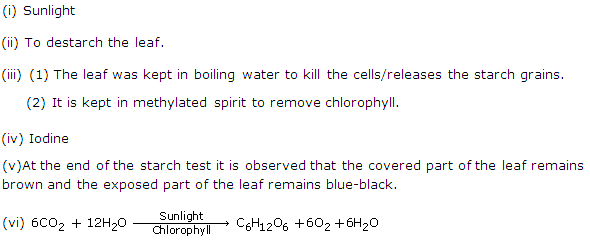
Question 2
Choose the correct answer:
(i) Which one of the following is the best reason for leaving a plant in a dark place before carrying out experiments on photosynthesis?
(a) To remove chlorophyll from the leaves.
(b) To increase the release of CO2 by the leaves.
(c) To remove starch from the leaves.
(d) To stop synthesis process in the leaves.
(ii) Which one of the following features of plant leaves plays an important part in photosynthesis?
(a) Thick cuticle (b) Spongy mesophyll (c) Chloroplasts (d) Stomata
(iii) The specific function of light energy in the process of photosynthesis is to
(a) Reduce carbon dioxide
(b) synthesize glucose
(c) Activate chlorophyll
(d) split water
(iv) In a typical leaf, photosynthesis occurs mainly in
(a) Cuticle
(b) epidermis
(c) Palisade mesophyll
(d) spongy Mesophyll
(v) Energy is transformed from the light reaction to the dark reaction by
(a) Chlorophyll
(b) ADP
(c) ATP
(d) RuDP
(vi) A cell that lacks chloroplast does not
(a) Evolve CO2
(b) liberate O2
(c) Require water
(d)utilize carbohydrates
(vii) Light reaction takes place in
(a) Grana
(b) stroma
(c) Chloroplast membrane
(d) endoplasmic reticulum
(viii) Photosynthesis is more active in
(a) green light
(b) red light
(c) Yellow light
(d) violet light
(ix) Which of the following gas is used in photosynthesis?
(a) Oxygen
(b) Hydrogen
(c) Nitrogen
(d) Carbon dioxide
(x) The process of photosynthesis occurs by
(a) carbon dioxide and water
(b) carbon dioxide, chlorophyll and water
(c) water, chlorophyll, sunlight
(d) water, carbon dioxide, chlorophyll and sunlight
(i) Which one of the following is the best reason for leaving a plant in a dark place before carrying out experiments on photosynthesis?
(a) To remove chlorophyll from the leaves.
(b) To increase the release of CO2 by the leaves.
(c) To remove starch from the leaves.
(d) To stop synthesis process in the leaves.
(ii) Which one of the following features of plant leaves plays an important part in photosynthesis?
(a) Thick cuticle (b) Spongy mesophyll (c) Chloroplasts (d) Stomata
(iii) The specific function of light energy in the process of photosynthesis is to
(a) Reduce carbon dioxide
(b) synthesize glucose
(c) Activate chlorophyll
(d) split water
(iv) In a typical leaf, photosynthesis occurs mainly in
(a) Cuticle
(b) epidermis
(c) Palisade mesophyll
(d) spongy Mesophyll
(v) Energy is transformed from the light reaction to the dark reaction by
(a) Chlorophyll
(b) ADP
(c) ATP
(d) RuDP
(vi) A cell that lacks chloroplast does not
(a) Evolve CO2
(b) liberate O2
(c) Require water
(d)utilize carbohydrates
(vii) Light reaction takes place in
(a) Grana
(b) stroma
(c) Chloroplast membrane
(d) endoplasmic reticulum
(viii) Photosynthesis is more active in
(a) green light
(b) red light
(c) Yellow light
(d) violet light
(ix) Which of the following gas is used in photosynthesis?
(a) Oxygen
(b) Hydrogen
(c) Nitrogen
(d) Carbon dioxide
(x) The process of photosynthesis occurs by
(a) carbon dioxide and water
(b) carbon dioxide, chlorophyll and water
(c) water, chlorophyll, sunlight
(d) water, carbon dioxide, chlorophyll and sunlight
Solution 2
(i) (d) To stop synthesis process in the leaves.
(ii) (c) Chloroplasts
(iii) (d) split water
(iv) (c) Palisade mesophyll
(v) (b) ADP
(vi) (b) liberate O2
(vii) (a) Grana
(viii) (b) Red light
(ix) (d) Carbon dioxide
(x) (d) water, carbon dioxide, chlorophyll and sunlight
(ii) (c) Chloroplasts
(iii) (d) split water
(iv) (c) Palisade mesophyll
(v) (b) ADP
(vi) (b) liberate O2
(vii) (a) Grana
(viii) (b) Red light
(ix) (d) Carbon dioxide
(x) (d) water, carbon dioxide, chlorophyll and sunlight

0 comments:
Post a Comment